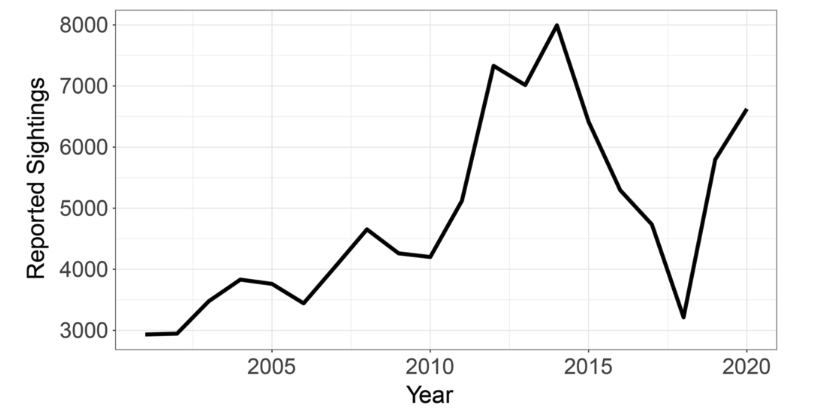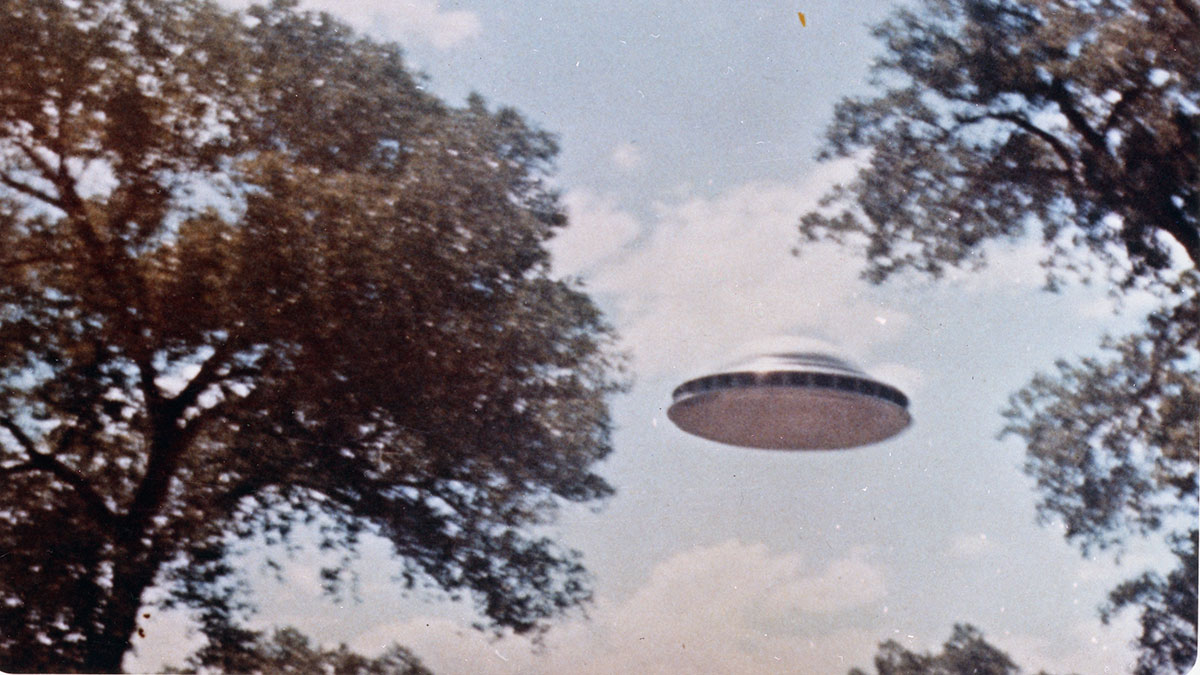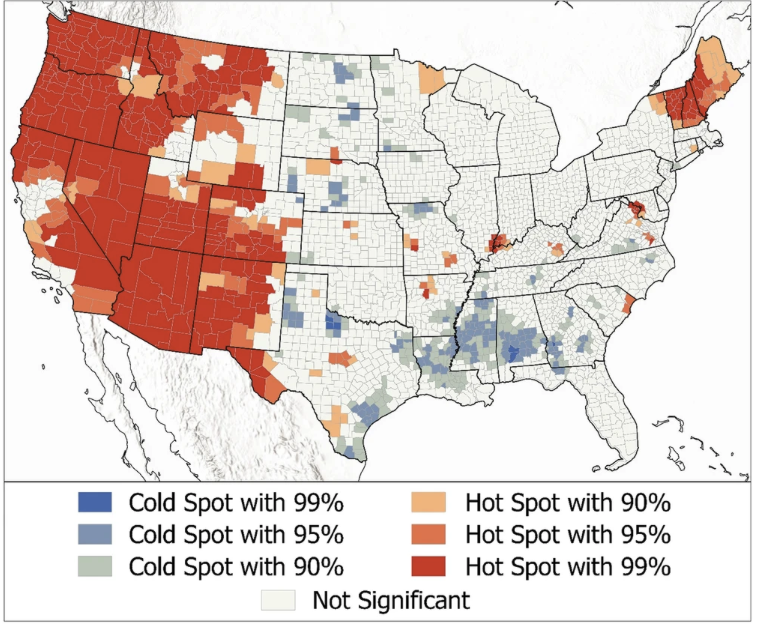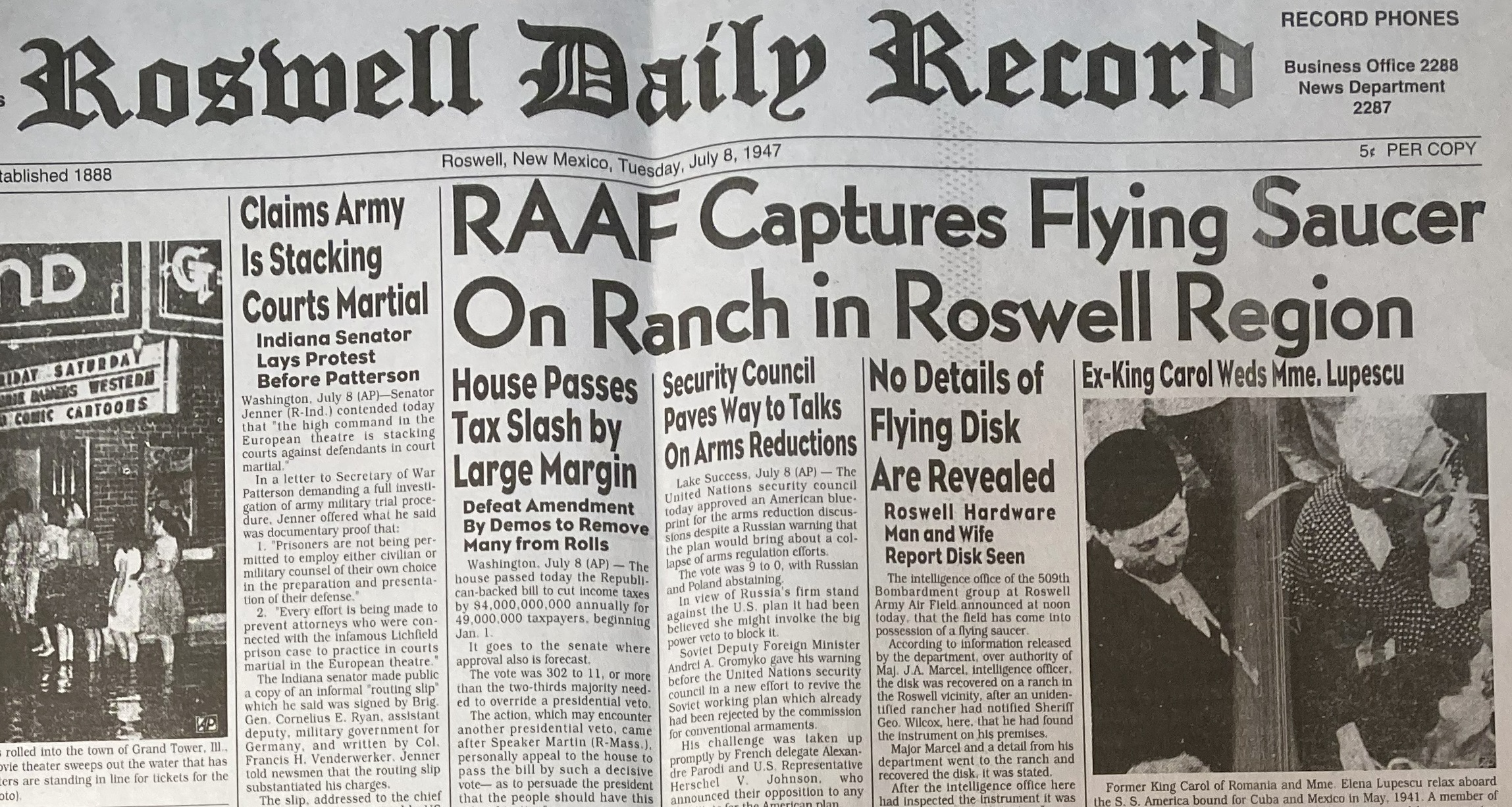The West is best to spot UFOs – @theU
“This [Tic Tac-shaped object that] had just traveled 60 miles in…less than a minute, was far superior in performance to my brand-new F/A-18F and did not operate with any of the known aerodynamic principles that we expect for objects that fly in our atmosphere.”
In July of 2023, retired commander in the U.S. Navy David Fravor testified to the House Oversight Committee about a mysterious, Tic Tac-shaped object that he and three others observed over the Pacific Ocean in 2004. The congressional hearings riveted the world by bringing Unidentified Anomalous Phenomena (UAP) out of the “alien truther” realm and into the mainstream.

PHOTO CREDIT: Medina, Brewer & Kirkpatrick. Sci Rep (2023)
Timeline of the National UFO Research Center reported sightings from 2001 to 2020.
As sensor technology has advanced and personal aircraft-use has skyrocketed, our ability to explain strange events has become harder to resolve. The U.S. Department of Defense has increasingly taken UAP, formerly known as Unidentified Flying Objects (UFOs), as a serious threat to national security.
A new study led by University of Utah geographers attempts to understand if local environmental factors increase or decrease the number of sighting reports. The authors used data from the National UFO Research Center, and included approximately 98,000 total sighting reports over a 20-year period, from 2001 to 2020. For each county in the contiguous U.S., the researchers analyzed two conditions: Sky view potential, which refers to the area’s light pollution, cloud cover and tree canopy cover; and the potential for objects to be present in the sky, meaning the proximity to airports and military installations.

PHOTO CREDIT: National Archives, records of headquarters U.S. Air Force
UFO sighting in Riverside, CA, November 23, 1951.
The majority of sightings were in western parts of the U.S. due to the region’s physical geography—lots of wide-open spaces and dark skies. UAP-reporting hotspots had credible relationships with air traffic and military activity, suggesting that people are spotting real objects, but not recognizing what they are.
“The idea is that if you have a chance to see something, then it’s more likely that you’re going to see unexplained phenomena in the sky,” said Richard Medina, associate professor of geography at the University of Utah and lead author of the study. “There’s more technology in the sky than ever before so the question is: What are people actually seeing? It’s a tough question to answer, and it is an important one because any uncertainty can be a potential threat to national security.”
Understanding the environmental context of these sightings will make it easier to find explanations for their occurrence and help identify truly anomalous objects that are a legitimate threat.
The paper published on Dec. 14, 2023, in the journal Scientific Reports.
Hot spots and cold spots
The authors looked at the number of sightings per 10,000 people per county and identified significant clusters of low numbers of reports (cold spots) and high numbers of reports (hot spots). There were far more sightings reported in the West and in the very Northeast, along some isolated areas. The cold spots were in the central plains and the Southeast. All results except for cloud cover supported the general hypothesis that people will see things when there’s an opportunity.

PHOTO CREDIT: Medina, Brewer & Kirkpatrick. Sci Rep (2023)
Hotspot analysis of reported sightings from 2001 to 2020.
“The West has a historical relationship to UAP—Area 51 in Nevada, Roswell in New Mexico and here in Utah we have Skinwalker Ranch in the Uinta Basin and military activity in the U.S. Army Dugway Proving Ground,” said Medina. “Plus, there’s a robust outdoor community that recreates in public lands year-round. People are out and looking skyward.”
Traditional academia has mostly avoided UAP research because of the stigma of flying saucers and space invaders. Yet people around the world continue to spot unexplainable objects in the sky. What little research exists tends to rely on firsthand accounts or look for cultural and psychological explanations, which limits the ability to analyze patterns over a large area.
Additionally, legitimate data sources and questionable accounts have limited rigorous study. The authors note that the National UFO Research Center’s data is a public, self-reporting system with no real way to verify hoaxes. However, the authors assert that if the data were entirely invalid due to some psychological and sociological cause, then there would be no spatial pattern. But there is.
“There are many factors that can contribute to the report of anomalous objects,” said Simon Brewer, associate professor of geography at the U and co-author of the study. “By examining the spatial distribution of reports and how they relate to the local environment, we hope to provide some geographical context that may help resolve or understand reports by both the public and in military settings.”
Roswell, X-Files and Starlink

PHOTO CREDIT: Roswell Daily Record via Wikimedia
Front page of the Roswell Daily Record for July 8, 1947.
In July of 2022 the U.S. Deputy Secretary of Defense, in coordination with the Director of National Intelligence, directed the establishment of the All-domain Anomaly Resolution Office (AARO) as the single authoritative UAP office to lead and synchronize a whole government approach to the issue. Earlier UAP tracking efforts include Project BLUE BOOK, a U.S. Air Force-led project that investigated UFO sightings between 1947 and 1969. Project BLUE BOOK’s most famous report is the Roswell, New Mexico, incident alleging that a flying saucer crashed in the desert town on July 8, 1947, and its alien occupants were recovered by government officials. Many Roswell residents witnessed the unexplainable event, which may have led to the flurry of flying-saucer-sightings that swept the nation. Silence from government officials led to wild speculation of otherworldly visitors and subsequent coverups. Later, the U.S. Air Force disclosed that the incident was caused by a classified, multi-balloon project to detect Soviet nuclear tests.
Many UAP sightings have a natural explanation—the planet Venus is a regular culprit, for example. The last few years have seen a boost in UAP reports, likely related to the exponential growth in spacecraft launches and orbiters, such as the Starlink satellite-train blazing across the night sky and the ubiquity of personal drones. The challenge is to parse which reports signal a real threat.
The authors are exploring whether there are temporal considerations for fluctuations in sightings, based on socio-cultural triggers. For example, were there more reports after the congressional hearings in July of 2023 or after a Space X launch? They’re also investigating whether sociocultural factors influence UAP sightings—is there a spike in reports after a show like “X-Files” gets popular? Are some cultures more likely to see UAPs because of their beliefs?
“The U.S. government—the military, intelligence and civil agencies—needs to understand what is in the operating domains to ensure the safety and security of the nation and its people,” said Sean Kirkpatrick, first director of the AARO, adjunct assistant professor of physics at the University of Georgia and co-author of the study. “Unknowns are unacceptable in this age of ubiquitous sensors and data availability. The scientific community has a responsibility to investigate and educate.”
****
The study is titled: An environmental analysis of public UAP sightings and sky view potential can be found here: Medina, R.M., Brewer, S.C. & Kirkpatrick, S.M. An environmental analysis of public UAP sightings and sky view potential. Sci Rep 13, 22213 (2023). https://doi.org/10.1038/s41598-023-49527-x
MEDIA & PR CONTACTS
This article has been archived for your research. The original version from Google News can be found here.


